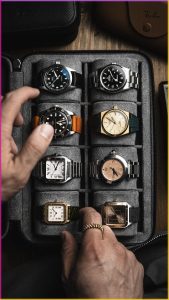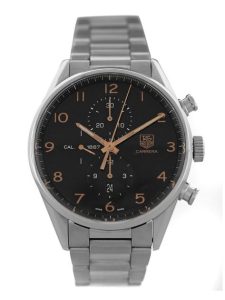Uncategorized
How to Read and Understand Watch Specifications
When it comes to purchasing a watch—whether it’s your first or an addition to a growing collection—understanding the watch specifications is essential. Watch specifications provide crucial details about the watch’s features, performance, and quality. For many watch enthusiasts, these technical details are not just informative; they are what make a timepiece truly special.
In this guide, we’ll walk you through the most important watch specifications, what they mean, and how to interpret them. By the end of this article, you’ll have a solid understanding of watch specifications, enabling you to make informed decisions when purchasing a watch or comparing models.
1. Movement: The Heart of the Watch

The movement (also known as the “caliber”) is the mechanism that powers the watch, determining how it keeps time and functions. There are several types of movements found in watches, and understanding them is crucial for evaluating the quality and functionality of a timepiece.
- Mechanical Movement: Mechanical watches are powered by a mainspring, a coiled wire of metal that stores energy. These watches can either be manual (requiring winding by hand) or automatic (self-winding by the movement of the wrist).
- Manual requires winding the crown to store energy in the mainspring.
- Automatic watches wind themselves as you move your wrist, though they can be manually wound if not worn for some time.
- Quartz Movement: Quartz watches are powered by a battery and use a quartz crystal to regulate time. They are known for their accuracy, affordability, and low maintenance since they don’t require winding.
- Hybrid Movements: Some watches combine both mechanical and quartz technologies, such as kinetic or solar-powered watches, which use motion or sunlight to charge the watch’s battery.
How to Read It: The movement type is often listed on the specification page or the case back of the watch. If you’re looking for precision and low maintenance, quartz is a great option. If you prefer traditional craftsmanship and the art of horology, a mechanical movement might be more your style.
2. Case Material
The case refers to the outer shell of the watch that houses the movement. The material used to construct the case affects not only the aesthetics of the watch but also its durability, weight, and price.
- Stainless Steel: One of the most common materials, stainless steel is durable, resistant to corrosion, and relatively affordable. It’s often used for both casual and luxury watches.
- Titanium: Lighter than stainless steel, titanium is also highly resistant to scratches and corrosion. It’s an ideal material for those looking for a robust yet lightweight timepiece.
- Gold: Watches made from gold (usually 18k or 14k) are luxurious and can be either yellow, white, or rose gold. Gold watches are typically more expensive and are highly sought after for their aesthetic appeal.
- Ceramic: Ceramic cases are lightweight, scratch-resistant, and hypoallergenic. They’re often used in high-end watches and offer a modern, sleek appearance.
- Platinum: A rare and expensive metal, platinum watches are the epitome of luxury, prized for their durability and prestige.
How to Read It: The material will usually be mentioned directly in the product specifications. For instance, “stainless steel case” or “titanium case” will give you an idea of both the aesthetics and the overall quality of the watch.
3. Water Resistance
Water resistance refers to a watch’s ability to withstand water exposure. This is an important factor to consider depending on how you plan to use the watch. Water resistance is typically measured in meters (m) or atmospheres (ATM).
- 30m/3ATM: This level of water resistance means the watch can withstand splashes or light rain but should not be submerged.
- 50m/5ATM: Suitable for light swimming, but not for diving.
- 100m/10ATM: Good for swimming and snorkeling.
- 200m/20ATM or more: These watches are typically designed for scuba diving.
How to Read It: The water resistance rating is usually listed on the dial or case back of the watch. Keep in mind that even if a watch is labeled as “water-resistant,” it doesn’t mean it’s completely impervious to water. It’s always wise to avoid exposing any watch to excessive moisture if it’s not rated for it.
4. Dial and Display Type
The dial is the face of the watch, and its design can vary greatly depending on the brand and model. The type of display (analog or digital) and the specific features found on the dial can give you an idea of the watch’s functionality and aesthetic.
- Analog: This is the traditional watch design with hour, minute, and sometimes second hands. It can feature numbers or indices for reading time.
- Digital: Digital watches display time using numbers, often in an LCD or LED format.
- Analog-Digital: Some watches offer a hybrid of both, with analog hands for traditional timekeeping and a digital display for additional features (e.g., date, alarms, world time).
- Chronograph: A chronograph watch features a stopwatch function, with additional sub-dials to measure seconds, minutes, and sometimes even hours.
- Skeleton: A skeleton watch has a transparent dial or case back, allowing the wearer to see the inner workings of the mechanical movement.
- Moonphase: A moonphase watch tracks the phases of the moon, adding an additional aesthetic and functional feature to the dial.
How to Read It: The display type and additional complications are often detailed in the specifications or product description. If you’re after simplicity, look for an analog dial with minimal features. If you enjoy multitasking, a chronograph or an analog-digital hybrid may suit you better.
5. Crystal Material
The crystal is the transparent cover over the watch dial, protecting it from scratches and damage. The type of crystal used affects the durability and appearance of the watch.
- Mineral Glass: A common and affordable choice, mineral glass is resistant to shattering but can scratch more easily.
- Sapphire Crystal: Considered the gold standard for watch glass, sapphire crystal is highly scratch-resistant and durable. It’s more expensive but found in most luxury and high-end timepieces.
- Acrylic Glass: Lightweight and inexpensive, acrylic is often found in vintage or budget-friendly watches. It is prone to scratching but is easily polished.
How to Read It: Check the product specs for crystal material. If durability and scratch resistance are a priority, look for watches with sapphire crystal.
6. Case Diameter and Thickness
Case diameter refers to the width of the watch case, measured from one side to the other (excluding the crown). Case thickness refers to how thick the case is. These measurements affect the comfort, wearability, and overall style of the watch.
- Small (36-40mm): A classic size that suits most wrist sizes, particularly for those with smaller wrists or those seeking a more subtle, vintage look.
- Medium (40-44mm): A versatile size that fits most wrist types, often found in both men’s and women’s watches.
- Large (44mm and above): Bold and eye-catching, large watches are trendy and suit larger wrists or those who prefer a more statement-making design.
How to Read It: The case diameter and thickness are typically listed in millimeters (mm) in the product specifications. Choose a size that fits your wrist and matches your style preferences.
7. Power Reserve

The power reserve refers to how long a watch will run once it has been fully wound (for mechanical watches). This is an important specification for mechanical and automatic watches, as it indicates how much time you have before the watch stops running.
- Short Power Reserve: Watches with a short power reserve (around 24-36 hours) will need to be wound regularly.
- Long Power Reserve: Watches with a longer power reserve (over 40 hours) can run for a longer period without requiring winding.
How to Read It: For mechanical and automatic watches, look for the power reserve listed in hours. If you don’t wear the watch daily, a longer power reserve will be more convenient.
Conclusion
Understanding watch specifications is key to choosing the right timepiece for your needs and preferences. By examining the movement, case material, water resistance, dial features, crystal type, case size, and power reserve, you can evaluate a watch’s functionality, durability, and aesthetic appeal.
Next time you’re in the market for a watch, don’t just look at the surface—dig into the specifications. The right watch will not only reflect your style but also align with your lifestyle and practical needs. Whether you’re after a casual everyday watch, a luxury investment, or a high-performance sports model, understanding these key specs will help you make an informed decision.

